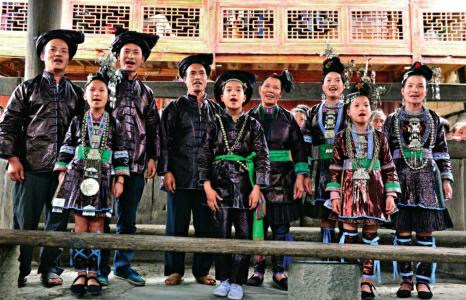Hu Guanmei–Kam Grand Choir Inheritor
By+staff+reporter+JOY+JIAO
BABBLING brooks and towering ancient maples form the idyllic scenery of Zaidang Village, a mountain community of the Dong ethnic group and home to Hu Guanmei. The melodious singing of the Kam Grand Choir can be heard from afar by approaching visitors. It is Hu, teaching children to sing, something she has done for the past 38 years.
Zaidang is the birthplace of the Kam Grand Choir, and Hu is one of the most famous singers of this polyphonic choral technique, and the first choice for anyone looking for a singing teacher.
Hus dedication to the Kam Grand Choir is remarkable. When her children were babies, she would receive students until late at night, cradling her babies in her arms as she taught. Its no wonder her children all learned to sing from a young age. Hu saw this as part of her job, “I needed to take every opportunity to pass on my skills to my children, otherwise the art of the Kam Grand Choir would risk extinction,” Hu said.
Love for Music
“Food for the body; song for the mind” has been a motto among the Dong people for generations. Hus father was a famous singing master in the local area and he made a strong impression on Hu throughout her childhood.
Hu soon became the best female singer in her village and her fame spread to the surrounding ar-eas. Thanks to her good memory, Hu can perform over 100 Dong songs and has mastered various singing techniques. Such talents are seen as desirable by young Dong men. The story goes that it was during a local match-making ritual that a young man named Yang Shengjin won Hus heart with his singing. They soon married and the couple moved to Zaidang Village where Hu started to work towards becoming a singing master.
Before a training school was built in the village, children would spontaneously gather at Hus home after dinner; the living room became her classroom. Hu held voluntary classes at home for three decades, during which time she continued to learn, practice, and share Dong songs, teaching more than 200 students in total.
Her outstanding contribution to the inheritance of the Kam Grand Choir resulted in the local government selecting Hu as excellent singing master in 2004. In 2007, she won the title of Outstanding Inheritor of Chinese Folk Culture awarded by the China Federation of Literary and Art Circles and the Chinese Folk Literature and Art Society. In 2013, Hu was named an official inheritor of Chinas national intangible cultural heritage.endprint
Spreading Ethnic Histories
One of Chinas 55 ethnic minorities, the Dong people mainly live on the borders of Guizhou Province, Hunan Province, and Guangxi Zhuang Autonomous Region. The Dong culture has three icons: drum towers, wind-and-rain bridges, and the Kam Grand Choir.
With a history of more than 2,500 years, the Kam Grand Choir currently prevails in Liping, Congjiang, and Rongjiang counties of Guizhou, and Sanjiang County in Guangxi. As a folk polyphonic chorus, there is no need for accompaniment or a conductor. Comprised of many low pitches and a solo high pitch, this singing mode requires at least three people to perform, but the more, the better.
The Dong language has no written form. Therefore, singers learn by oral teaching. It is thought that this method inspires innate understanding. A huge amount of cultural heritage, living customs, and social etiquette have been passed from generation to generation via the Dongs melodic songs.
The Kam Grand Choir is the essence of Dong culture, without which it would not thrive the way it does today. But due to the aggressive influence of modern life, this tradition has waned in some Dong communities. Owing to the remote location of Zaidang Village, however, residents there have been able to fully maintain the Kam Grand Choir techniques.
At night, Hus house comes to life; dozens of children sit in her living room and learn how to sing. As well as teaching them simple childrens songs, Hu and her daughters, Yang Xiuzhu and Yang Xiumei, teach some of the older students polyphonic singing in its original form, phrase by phrase.
The Kam Grand Choir consists of vigorous male and clear female vocals. Lyrics mainly depict love, heroic figures, daily life, historical stories, and nature. Since the singing style is different for male and female singers, Hu teaches girls only. “The first thing my students need to be able to do is to recite the lyrics from memory. Then, I teach them about the bass, how to take turns in pausing for a breath, and how to keep their voices smooth and steady. Finally, I teach them the treble,” said Hu, who selects only the best to form a choir.
Family of Kam Grand Choir Singers
Hu is very proud of her two daughters, whom she considers to be her greatest achievements.
As soon as they started to speak, the sisters began to sing. According to Yang Xiuzhu, whenever they helped their mother in the field, they would practice their singing, eventually mastering even the most emotive lyrics.endprint
In 1995, when Yang Xiuzhu was a student at junior high, she had the chance to perform a Kam Grand Choir song. Her performance went wonderfully, and won admiration from her teachers and peers, also an award. Bolstered by Yang Xiuzhus success, the sisters were encouraged to learn more from their mother, and to spread the art to more places.
As her daughters grew up, Hu encouraged them to take part in singing contests. They gradually became known in the local area as “the sister singers,”and went on to lead teams to victory at the National Young Singers Contest in 2006 and 2008. The two have also performed overseas. They now devote themselves to the spreading of the Dong culture like their mother. “In addition to teaching children, I lead two choruses in my spare time,” said Yang Xiuzhu, “Its my duty.”
Influenced by Hu Guanmei, her elder son-inlaw, son, and daughter-in-law have all learned Kam Grand Choir singing. Together, they make up a family of Kam Grand Choir singers.
But what makes Hu most proud is that, thanks to her familys efforts, almost everyone in Zaidang Village knows how to perform Kam Grand Choir, which means that Zaidang Village will remain the hometown of this indigenous singing form for years to come.endprint

